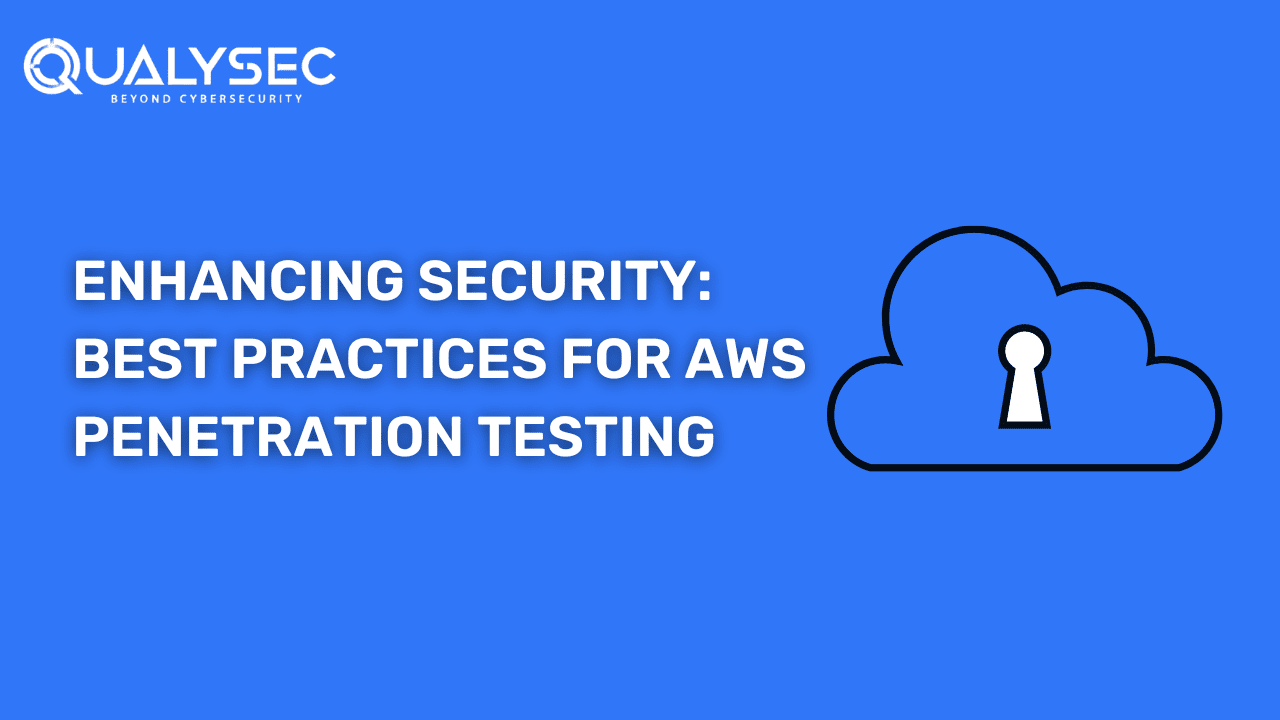
In today’s rapidly evolving digital landscape, security is paramount for organizations. As the cloud becomes increasingly prevalent, Amazon Web Services (AWS) stands out as a leading provider. Conducting AWS penetration testing in the USA is crucial to ensure the security of cloud-based assets. In this engaging blog post, we will explore what AWS penetration testing entails, the importance of conducting it, AWS’s stance on penetration testing, and best practices to enhance security. So, let’s dive into the world of AWS penetration testing and uncover the secrets to safeguarding your valuable resources
Imagine a digital fortress protecting your organization’s data and applications. AWS penetration testing is like a trial by fire for that fortress. It involves actively assessing the security of your AWS infrastructure by attempting to exploit vulnerabilities, misconfigurations, or weaknesses. By simulating various attack scenarios, you can identify potential risks and ensure the robustness of your security controls.
With data breaches and cyber threats on the rise, the importance of AWS penetration testing cannot be overstated. It allows you to proactively identify vulnerabilities before malicious actors do, reducing the risk of data breaches, financial losses, and reputational damage. By conducting penetration testing, you gain valuable insights into the strengths and weaknesses of your AWS environment, enabling you to implement effective security measures.
Yes, AWS allows penetration testing, but with certain conditions. Organizations must obtain explicit written permission from AWS to conduct penetration testing activities. This permission ensures that the testing is authorized and prevents any legal complications or misunderstandings.
Penetration testing
Traditional penetration testing primarily focuses on assessing the security of on-premises infrastructure, including servers, network devices, and applications hosted within an organization’s own data centers. It involves simulating various attack scenarios to identify vulnerabilities and weaknesses that could be exploited by external or internal threats. Traditional penetration testing often follows a standardized methodology, such as the Open Web Application Security Project (OWASP) or the Penetration Testing Execution Standard (PTES).
AWS Penetration Testing
AWS penetration testing specifically targets the security of resources and services hosted on the Amazon Web Services (AWS) cloud platform. It takes into account the unique challenges and complexities presented by cloud environments. AWS penetration testing aims to identify vulnerabilities, misconfigurations, and weaknesses within AWS services, including EC2 instances, S3 buckets, RDS databases, and IAM roles.
There are several existing methodologies for conducting AWS penetration testing, including:
Before conducting an AWS penetration test, it is essential to prepare adequately. This involves the following steps:
Understanding the various AWS cloud services is essential for effective penetration testing. Familiarize yourself with services such as Amazon EC2, Amazon S3, Amazon RDS, and AWS IAM, as they are commonly targeted by attackers.
Suggested Tools for Performing AWS Penetration Testing: There are several tools that can assist in performing AWS penetration testing. Some popular options include:
AWS Security Token: AWS Security Token Service (STS) enables you to grant temporary access to AWS resources to perform testing without compromising the long-term security of your account.
External Reconnaissance: External reconnaissance involves gathering information about the target AWS infrastructure from publicly available sources, such as DNS records, public IP addresses, and open ports.
Local Filesystem: Testing the local filesystem on AWS instances involves assessing file permissions, sensitive information exposure, and potential misconfigurations that could lead to unauthorized access.
Now, you might wonder if AWS even allows penetration testing. The answer is a resounding “yes!” AWS recognizes the importance of penetration testing and permits it. However, it comes with a caveat. To conduct AWS penetration testing in the USA, you must obtain explicit written permission from AWS. This permission ensures that your testing activities are authorized, preventing any legal complications or misunderstandings.
Now that we understand the importance and permission aspect, let’s explore the best practices for AWS penetration testing in the USA:
Before embarking on your AWS penetration testing journey in the USA, it’s crucial to obtain explicit written permission from AWS. This step ensures that you are authorized to assess the security of your own infrastructure, paving the way for a smooth and legitimate testing process.
Clear goals are essential for any successful endeavor. Similarly, in AWS penetration testing, clearly define the scope and objectives of your testing engagement. Identify the specific AWS assets and services you want to test, such as EC2 instances, S3 buckets, or RDS databases. This focused approach helps ensure comprehensive coverage and efficient resource utilization.
To prevent any unintended damage or disruption to critical systems, always conduct penetration testing in a separate environment rather than testing directly on production resources. AWS provides tools like Amazon Virtual Private Cloud (VPC) and AWS Organizations, enabling you to create isolated testing environments with controlled access. This way, you can unleash your testing prowess while keeping your live environment unscathed.
To truly gauge the effectiveness of your AWS security measures, approach penetration testing from the perspective of a potential attacker. Think like a cunning hacker and consider a variety of attack vectors such as network-based attacks, application-level vulnerabilities, or even social engineering techniques. This approach helps identify weaknesses that might be overlooked by traditional security measures.
AWS offers a treasure trove of security services and tools to fortify your AWS penetration testing efforts. These tools act as your trusty sidekicks throughout the testing process. For instance, AWS CloudTrail provides detailed logs of API activity, AWS Config helps assess resource configurations, and AWS GuardDuty identifies potential malicious activities. By integrating these tools into your testing process, you gain deeper insights and enhance your security posture.
A robust AWS penetration testing strategy involves conducting a comprehensive vulnerability assessment. This entails using automated scanning tools like AWS Inspector, open-source tools like OWASP ZAP or Nmap, or even commercial vulnerability scanners. Regularly update these tools to stay ahead of the ever-evolving threat landscape and identify common vulnerabilities and misconfigurations.
IAM is the backbone of AWS security. As you embark on your AWS penetration testing in the USA, it’s crucial to assess IAM roles, policies, and permissions. Verify that users have the appropriate access levels and adhere to the principle of least privilege. Weak or misconfigured IAM settings can open doors to unauthorized access and potential data breaches.
Your AWS infrastructure’s network security controls play a vital role in preventing unauthorized access and data exfiltration. During penetration testing, assess the effectiveness of security groups, network ACLs, and AWS Web Application Firewall (WAF). Look for misconfigurations or gaps that could potentially expose your resources. Regularly review and update these controls to align with the changing threat landscape.
As data is the lifeblood of your organization, evaluating the security of your data storage services is paramount. During AWS penetration testing, scrutinize data storage services like Amazon S3 or Amazon RDS. Verify that data encryption is properly implemented, both in transit and at rest. Additionally, check for any publicly accessible resources and validate the integrity of access controls and permissions to prevent unauthorized data exposure.
Document all findings, vulnerabilities, misconfigurations, and potential risks discovered during AWS penetration testing. Assign severity levels to each issue and prioritize remediation efforts accordingly. Develop a comprehensive plan of action to address the identified issues. Remember, the testing journey doesn’t end with documentation; it’s essential to regularly review and retest security controls to ensure fixes have been properly implemented.
Several tools can aid in AWS penetration testing, including:

Qualysec, A Cybersecurity company founded in 2020 is a leading cybersecurity provider. Qulaysec is also known for its renowned cutting-edge technology and expertise in cybersecurity assessments. With a team of skilled professionals, Qulaysec offers a comprehensive range of services, including various vulnerability assessments and penetration testing.
What sets Qulaysec apart is its commitment to staying ahead of the curve in terms of emerging threats and advanced hacking techniques. They employ state-of-the-art tools and methodologies to ensure thorough and accurate assessments. Qulaysec’s team of experienced professionals brings a wealth of knowledge and a human touch to their engagements. This in turn helps foster collaboration and deliver actionable insights.
Technicians at Qualysec can detect flaws that fraudsters could abuse. After these flaws have been found, Qualysec collaborates with the organization to establish a plan to address them and boost the company’s overall security posture. Among the several services available are:
Hence, choose Qualysec for comprehensive and reliable Cloud Penetration Testing in India. Also, their penetration testing guide will help you make informed decisions and understand the various factors that impact the cost. Hence, protect your assets and enhance your security posture by choosing us.
Qualysec is a recognized AWS penetration testing provider. They offer comprehensive penetration testing services tailored specifically for AWS environments, ensuring the security of your cloud infrastructure and applications. Their expertise, tools, and methodologies can help organizations identify vulnerabilities and implement effective security measures.
AWS penetration testing in is an essential practice to identify and mitigate potential security risks within your cloud infrastructure. By following the best practices mentioned above, obtaining proper authorization, defining clear goals, simulating real-world attack scenarios, and leveraging AWS security tools, you can enhance the security of your AWS resources and protect your valuable data. Remember, AWS penetration testing is an ongoing process. Stay vigilant, adapt to the evolving threat landscape, and continuously test, assess, and strengthen your AWS security to safeguard your organization’s digital assets.
Qualysec has a successful track record of serving clients across a range of industries such as IT. Their expertise has helped clients identify and mitigate vulnerabilities, prevent data breaches, and improve their overall security posture.
When it comes to comprehensive cloud penetration testing Qualysec is the organization to go with. Their cost of VAPT guide helps clients make informed decisions by understanding the various factors that affect the cost by clicking here.